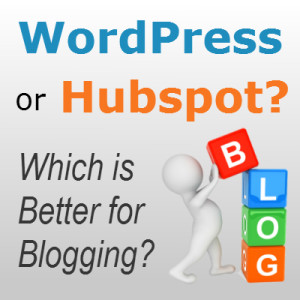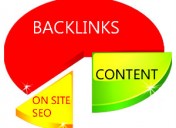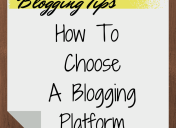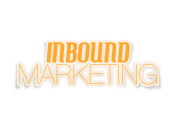WordPress vs Hubspot for Blogging- Which Is Better?
 Hubspot is the leading inbound marketing software. It’s not often I speak to someone who hasn’t heard of it, due to their active education on the topics that surround it, and I’m sure companies that can afford the price sign up when they are ready to begin inbound marketing.
Hubspot is the leading inbound marketing software. It’s not often I speak to someone who hasn’t heard of it, due to their active education on the topics that surround it, and I’m sure companies that can afford the price sign up when they are ready to begin inbound marketing.
I love Hubspot, the analytics are the best. I’m sure many of the same reports can be found on Google Analytics if you know how to set it up (or take the time to) but to login and immediately be able to see them in Hubspot is much easier. Hubspot also offers a visitor tracking feature that until recently was very difficult to find for WordPress sites.
That said, the entire user interface for Hubspot is gorgeous, it makes sense intuitively and I haven’t seen many softwares that cover so many features in one place. These features include a website, blog, email marketing, landing pages, analytics and social media= the whole package.
That all said, I’m far too frugal to pay for Hubspot for my own business. It isn’t that I can’t, it’s just that at the end of the day spending $200-$850 a month for something I can simulate (for the most part) on WordPress isn’t worth it for me. I am primarily a blogger and while I do have landing pages, I can still make WordPress work.
I have used WordPress for several years. I began on Blogger, moved to WordPress.com and then discovered I could have my own WordPress site. I never looked back. Even today, while I love the analytics Hubspot offers, I choose WordPress for functionality as well as price.
Blogging on Hubspot and WordPress
Hubspot has a blogging feature, but compared to WordPress it doesn’t measure up on functionality. It is a very simple area on Hubspot with a WYSIWYG editor.
Hubspot offers tool-tips on how long the article should be for SEO purposes (which I disagree with), and the user can edit in their SEO meta tags, with more tooltips for guidance. Save for the tags area, and inserting the CTA there is little left to do on the page.
For the record- while Hubspot does a great job with educating users about SEO, some focus too much on meeting the SEO suggestions rather than providing useful content the client or visitor.
WordPress on the other hand has endless possibilities, and that alone is the main reason I and so many VARs (Hubspot service providers) prefer to stick with WordPress for clients and blogging.
As I write this post I have few options available on the screen for my post, because I like to minimize distractions, however in the top right I can change all of that by adding custom fields, changing the author, sharing automatically to social media, adding an excerpt, changing the blog post layout and more.
That is with just a few plugins, I’ve seen many blogs (as I am a contributing author) with several other admin options for creating a post. There are research tools for finding articles to link to, visual editors to add extensive format options and ad options a user can take advantage of. The possibilities are endless.
Images on WordPress vs Hubspot
One major pet peeve I have with Hubspot’s blogging software is the images. For resizing there is one option, simply choose the width of the photo- that’s it.
While WordPress does not have a robust editing feature the user is able to resize, crop and scale images. There are more options with captions, titles, alt tags and where the photo links to as well on WordPress.
Pinning to Pinterest
When the post is live, images on WordPress may have a hover ‘Pin It’ button that Hubspot does not feature. Pinterest has offered a piece of code to include in the website template and that may work with Hubspot but I personally have not been able to test this, nor have I seen it on a client’s site. With the popularity of Pinterest and the numerous ecommerce Hubspot users I would think it would be beneficial for them to have this option.
Featured Image & Blog Home Page
The featured image on WordPress would be a great addition to Hubspot as they advise users to use an excerpt for the front page of the blog. They say this increases page views. I personally find it annoying and think time spent on the site reading will be a better indication for SEO than leaving a front blog page that looks uninviting.
As of now there is no simple feature for choosing an excerpt or a featured image for the front blog page, Hubspot simply drags the first image used, if it used in the the first hundred words or so.
I take issue with this because images attract the eye and are a big part of blogging, they split up the text, and increase readability on the site. I might also like to choose a specific image not have the first one I use dragged up, but there is no option for this.
Social Sharing
Choosing what and when to share on social media is important when trying to reach the most followers. Using plugins on WordPress this can be handled from the blog post’s edit page.
Hubspot offers automatic sharing of a blog post -upon publication, but it is limited to the title, link and default hashtag. For the automatic sharing technique on Hubspot, I recommend users manually share instead.
Automatic Blog Post Sharing
Hubspot users can use BufferApp to do this, which all serious bloggers should have anyhow. There is a section of the Hubspot interface where the user can set up social media updates, but it isn’t easy to access when browsing the internet, as it is with Buffer or Hootlet.
The social section of Hubspot does however make it easy to select pages, posts, and landing pages, which is not a feature that can be found on WordPress.
Repetitive Blog Post Sharing
For many social media sites a company can simply share a post once and move on. Once in awhile they will have a throw back post, sharing an old link to bring even more traffic to the site. Twitter is a different story, old blog posts can (and should) be shared often to get more traffic to them.
This is done easily on WordPress with several plugins such as Tweet Old Post (something I use). For now, Hubspot users have a feature to promote a post several times in their social sharing area, but this does not go on indefinitely like it can with Tweet Old Post.
The only other option for these users is to buy and install TweetAdder and add each post to their ongoing tweets. Learn more about my thoughts on social sharing with Hubspot here.
URLs & RSS Feeds
Many search engine optimizers agree that keywords should be used in URLs and they are best used as close to the beginning of the link as possible.
Unfortunately on Hubspot while the user can choose their ‘slug’ the URL format includes many numbers prior to keywords. These numbers are useless to the reader and only act to make the URL longer and less web friendly.
http://www.domain.com/blog/bid/330628/Post-Name as opposed to
http://www.domain.com/Post-Name
The same can be seen with the RSS feeds. On WordPress the format is very simple www.website.com/feed making it easy to recall and use for other tools – like Feedly.
Additionally on WordPress the user can choose their URL format, in the permalinks setting, making beautiful URLs for SEO purposes.
Summary
As I noted early in the article, Hubspot has impressive reports that are very useful. Their visitor tracking that connects the visitor with some of their social media contact information is great for sales followups.
Hubspot is introducing a new COS system as well that provides unique content to the visitor based on the number of previous visits. For social media, the platform includes monitoring that allows for easy sharing of content links, as well as integration with sharing to numerous (unlimited) Linkedin groups.
Hubspot is still best for inbound marketing, they do offer the entire package. WordPress developers are catching up though.
WordPress is superior for blogging and there are several exciting new plugins that transform the admin area into an inbound ready platform.
Stay tuned to my newsletter to read my future post on WordPress Inbound Marketing Plugins one of which you’ll see below if you are viewing this post on my website.
Remember to give me your comments below!
© 2014, Social Media Consultant. All rights reserved.
No more rehashed trash. Deliver the content your readers so badly want to see. Every piece is written specific to the reader in mind. Work with a writer that provides results, and see a difference in your numbers.
Blog posts start at $100 each, bulk discounts given.
Related Posts
- ← 11 Tips To Provide Clients With Higher Quality Content
- 7 Reasons ‘Facebook Fraud’ is Seriously Flawed →













Nice post Mary. I followed over from the LI discussion. You are hitting on a number of reasons I keep my clients on WordPress while using Hubspot for many of their other tools. It’s not just blogging either. It’s the entire website. Maybe because I know WP better but I can’t see the same functionality in HS as I can with WP as a web publishing tool. I find it very limiting.
You say that “until recently” it was difficult to find user tracking functionality in WP. Does this mean you’ve found a way to do it? May I ask what you’re using?
Thank you for summing up what I’ve been trying to explain to our “Marketing” team for a month or so now. They’ve taken the plunge and invested in Hubspot and are “on board” to such an extent that they want the entire site, blog included, rebuilt in HS. All they’re looking at are analytics and they don’t care about the poor people (me) who actually have to maintain the site on a daily basis. WordPress’ page/post system is simply better designed to generate a site and keep things moving. Every time I have to use the HS editor to do something it’s like pulling teeth.
I also second Jim’s question. I’d love to know what other tools you’re using within WP to add functionality.
Thank you Matt, I’ll be writing shortly about my WP ideas. I actually started a new blog for it, but do not have the domain up just yet. If you have any trouble with Hubspot, let me know, maybe I can help.